IBARAKI – A TIME TRAVELER`S JOURNEY – PART 1
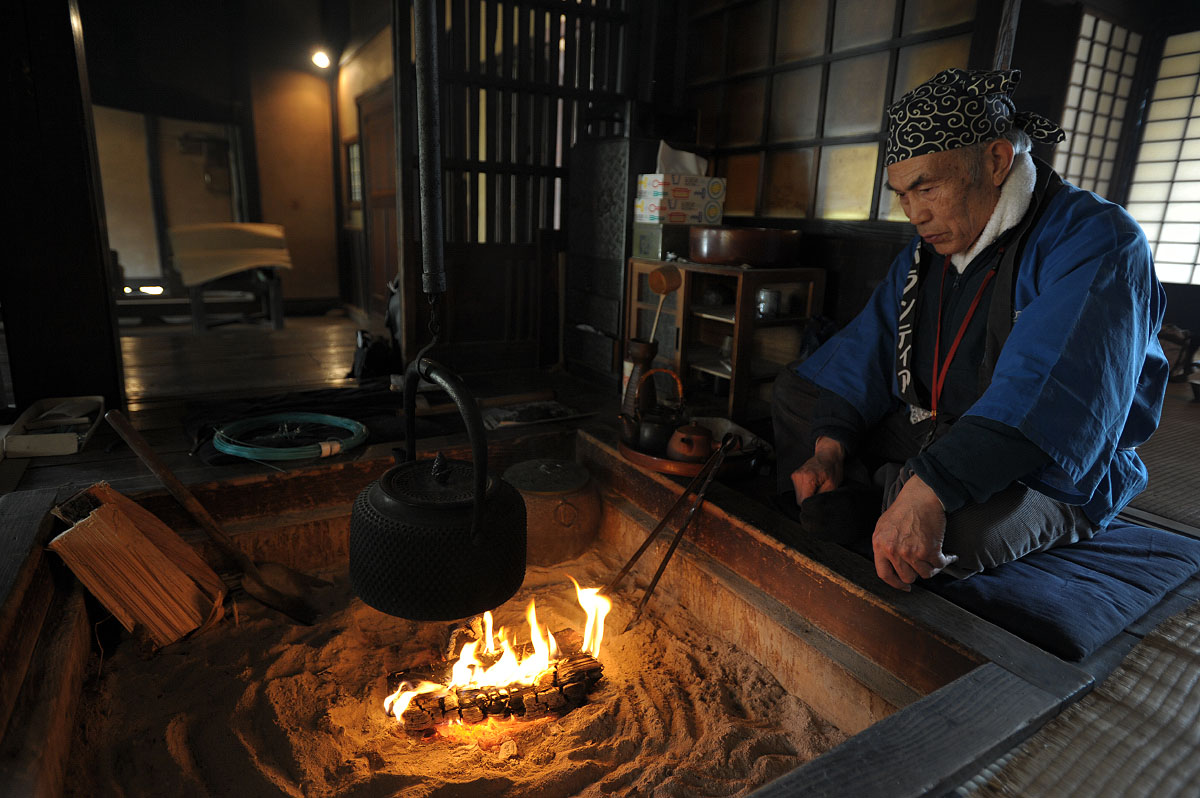
The alluring charm of Ibaraki can be an elusive creature. Akin to an ethereal breeze catching you unaware, it sweeps you into a serene adventure colored by a history laden past. Nestled in the northeastern area of the Kanto region, Ibaraki was considered a utopia in the early 8th century. A reputation garnered by fruitful harvests and lavish gifts from the ocean and surrounding mountains. This bounty nourished a Babylonian backdrop for the lifestyles of the rich and famous. The astounding heritage coupled with royal lineage ties to the Tokugawa Shogunate placed Ibaraki at the forefront of Japan`s political and economic dynasty allowing culture to bloom and to flourish during the Edo period (1603-1868). Powerful samurai generals and affluent priests once spent tranquil afternoons of leisurely contemplation amid immaculate gardens found throughout the prefecture. Their influence and penchant for architecturally stunning domiciles still remain to radiate their dominant shadows on the landscape.
In this episode, a small delegation of urban nomads was warranted the two day pass of exploration and with the guiding hand of spirited avatars from the Ibaraki Prefecture and the Japan Travel Bureau, we captured a glimpse into a foregone era still cherished with pride and honor to this day.
DAY ONE
Washi Museum – Hitachiomiya
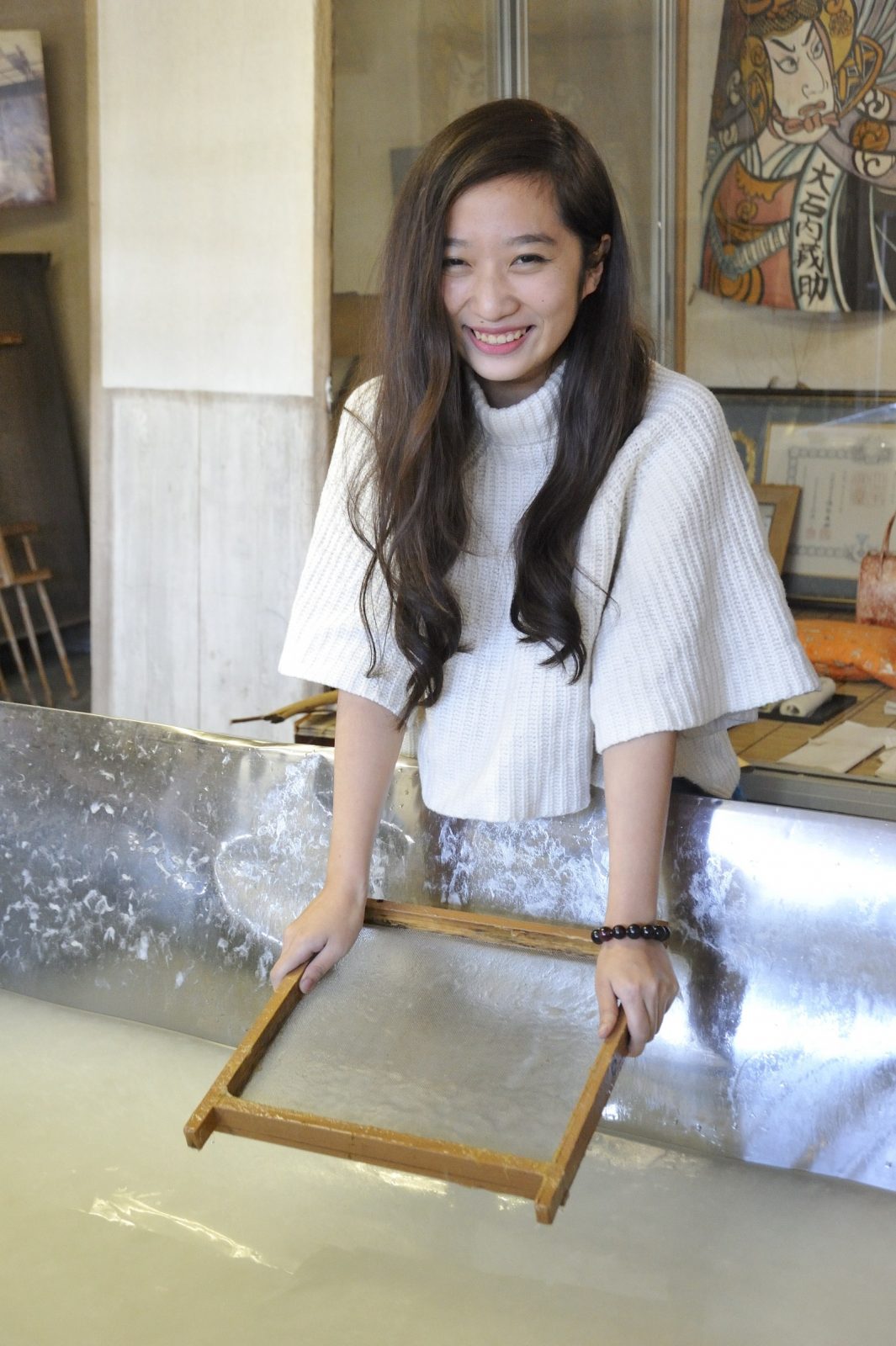
The genesis of traditional paper (washi) fabrication in Japan began as its reliance on Chinese imports waned amid growing confidence of superior, homegrown skills. Within the confines of a minimalist building, we mindfully cast our musings to the showcased remnants of past artists and the secular apparatus of their trade that adorned the interior of the establishment. A bespectacled, resident washi master, tempered by youth, engaged the gentle stares settling on him with tutelage and deft maneuvers as he motioned through the 1,400 year old techniques. The fibrous inner skin of the Gampi tree, common to this prefecture, is laboriously processed by hand. Numbingly cold water and a clear, lotion like gel derived from the Aibika root, a distasteful sister of the okra plant, serve to bind the three elements into a harmonious precursor of the written word. Utilizing a bamboo meshed screen (suketa) encased in wood, one simply immersed the device into the milky soup repeatedly, sifting back and forth, until a thin layer materialized and the water drained freely. We each took a turn at the helm as the washi master exuded patience and offered gracious counsel to the hands prone to chaotic tendencies. The measured act proved to be thrilling to those of us who could effectuate the desired end. For those participants who lacked the dexterity to yield a stately outcome, a lightly frustrated chuckle masked their inadequacies. We certainly were not craftsmen and our handiwork would prove a disgrace among the veterans of the art, but we were, for an ephemeral moment, novice artisans practicing a timeless craft.
Upon completion of our near sacrilegious attempt, we made a short jaunt across a remote, yet surprisingly busy stretch of road leading us to their commercial abode where they plied their wares. A mirage of colors, as if a rainbow had imploded within, sparkled and imparted a luster to the various memorabilia on display. The sheer variety of washi applications was overwhelming and after a tenuous moment of indecision, I settled on a letter stationary set that would add character to an old practice of communication.
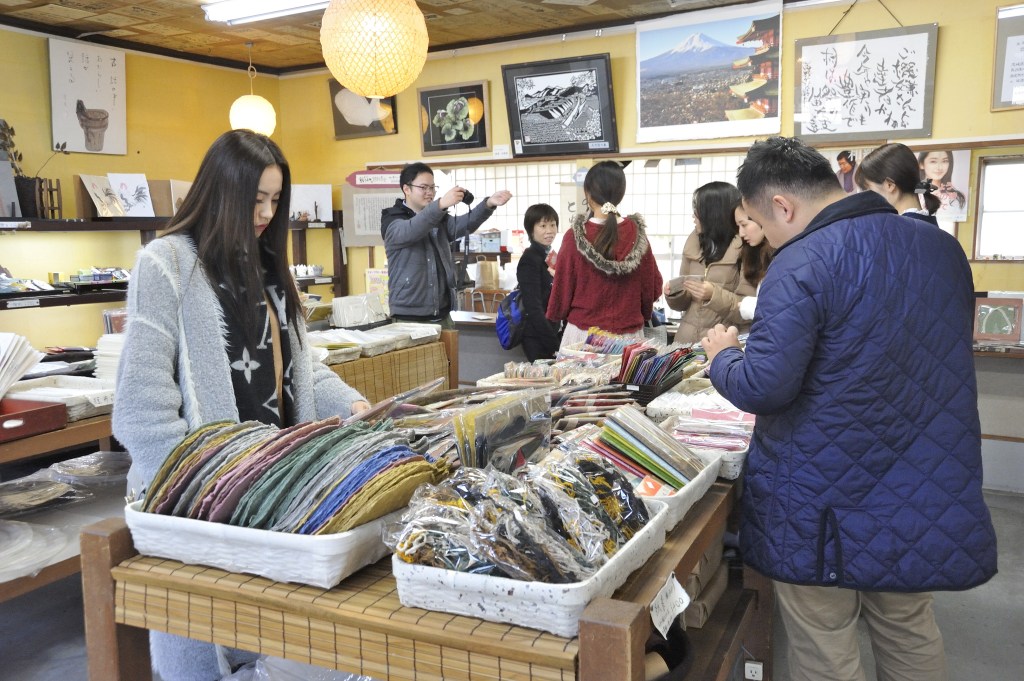
Irori Dining – Yakiyashintaku – Hitachiomiya
The practice of robatayaki (fireside cooking) hails from a style of preparing edibles by northern Hokkaido fishermen around a communal hearth (irori) that served as a cooking area and a source of heat against the cold touch of winter. This seminal art of food preparation gained widespread popularity in Japan and we reveled in its simplistic ideology and deliciousness.
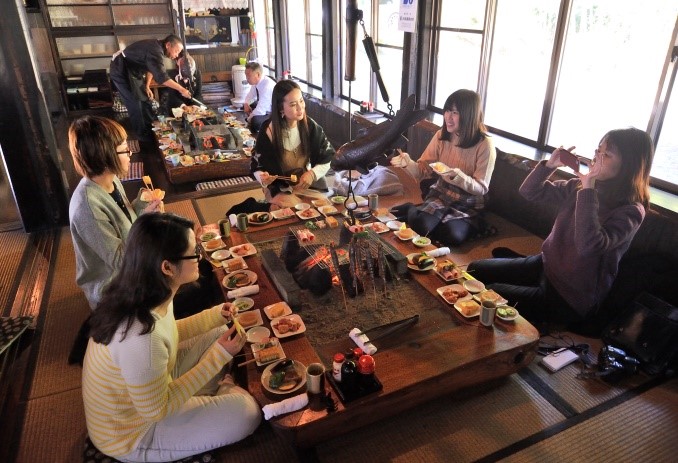
A picturesque table garnished by dishes of seasonal vegetables partnered with accents of meat and seafood drew us in immediately as the tickle of heat from the central fire pit offered welcome respite. Titanic shrimp skewered masterfully leaned into the burning embers eliciting a barrage of photographs to capture the dining epiphany. A few words of wisdom from the attentive staff imbued in us ample assurances to undertake the delightful task of chef for the day. Anyone new to cooking would immensely draw joy from this undertaking without fear of going hungry due to culinary mishaps. Signature plates of Japanese rolled eggs (tamagoyaki), vegetables stewed in soy sauce touched with sweetness and a chilled portion of handmade buckwheat noodles (soba) made that morning provided security measures. Choice cuts of marinated chicken, a slender block of firm tofu encased in a layer of delicately scorched skin, golden slivers of pumpkin (kabocha) and dainty slices of eggplant all vied for real estate on the fiery trestle. Elements of pride were slightly charred if not careful with your attentions, but a small sacrifice for the quiet conversations and vivid scenery that earned our distractions.

The feast was further accentuated by the rustic environment proffered by the 120 year old thatch house (gasshou-zukuri) that served as the palatial setting. Exposed rafters held loftily above our heads exhibited the complex network of layers and ties that would cause a mathematician to fumble for an answer to its inner workings. This method of roofing, dating back to the early 17th century, furnished its inhabitants with cool summers and cozy winters. If you removed the distractions of modern day electronics and the fashions of the moment, you would be hard pressed not to feel like a roving traveler enjoying the delicacies before you in a far off place in time.
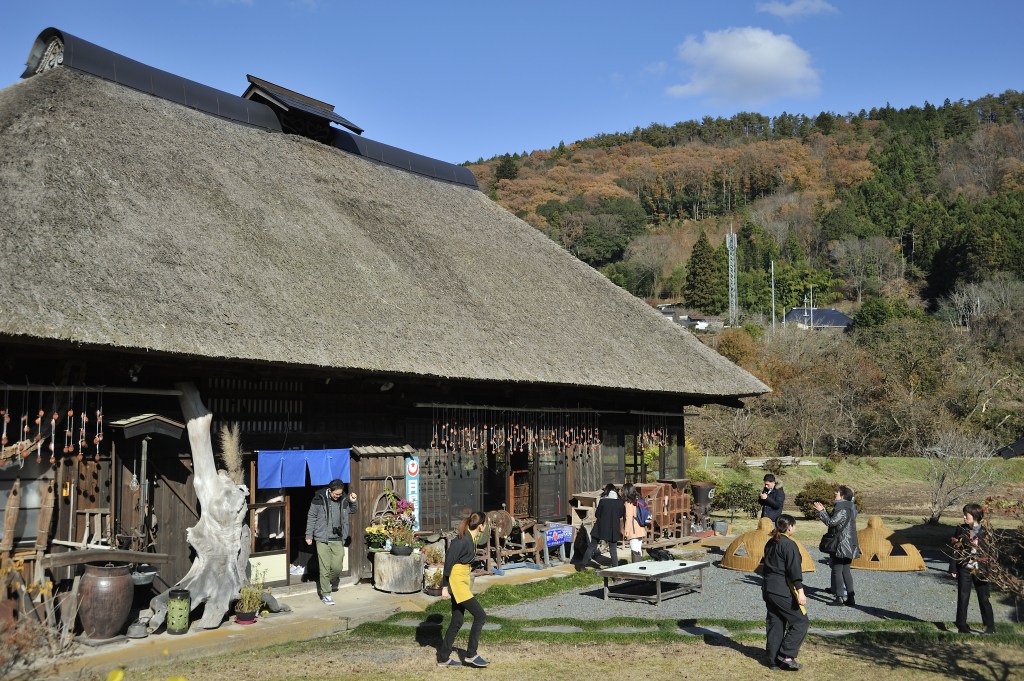
Hand Made Konnyaku – Daigomachi
A rather nondescript source of nourishment first thought to have been imported from China, Konnyaku possesses a 1,500 year résumé serving a medicinal role in the repertoire of Buddhist monks turned physicians. Present day appreciation for this innocuous jelly is geared toward weight loss, but it lurks in the pantry of almost every Japanese household for one iconic dish or another.
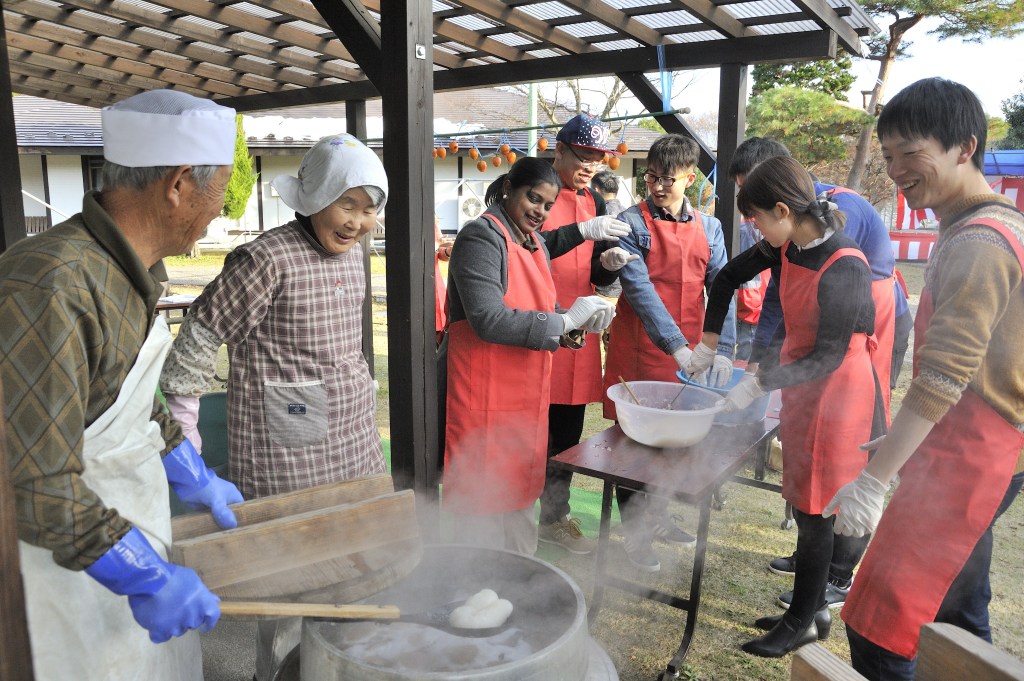
A genial, elderly couple, perhaps married, given their familiar engagement with each other, amiably tutored the group in the practice of Konnyaku making. A sorrowful looking tuber masking itself as a pumpkin was covered with dried soil having just been unearthed from nearly a four year subterranean slumber. Grated into an ivory gel, immersed in mountain water and mixed by hand with a cleverly devised bamboo implement, one simply shouldered one`s energy into the concoction until a thick porridge emerged. A starchy enzyme completes the transformation and within minutes, you had a coagulated blob of goodness. Formed roughly into a tennis ball sized mass, it is ceremoniously plunged into boiling water for thirty minutes.

A millennia of practiced consumption spawned rules for handling and should one fancy a palatable rendition, a thorough soak in water for two days relinquished the brazen bitterness from its flesh. For our toil, we were bequeathed a token portion of our efforts to ferry home. A recipe already flashed in my mind.
Oku Kuji Tea Park – Green Tea Curing – Daigomachi
We cast out our eyes to drink in the richly colored tea leave shrubs, neatly formed into curated hedgerows and covering the steeply angled hillsides. Despite their stoic demeanor, one pondered if they were fully cognizant of their fate to be sacrificed to the waiting patrons of its gossamer brew. A practice said to have emerged from the roots of cultivation back in 1191 in Uji, Kyoto, the elixir was only made accessible to the nobility and higher echelons of society. Green tea consumption for the general populace would not be available until centuries later.
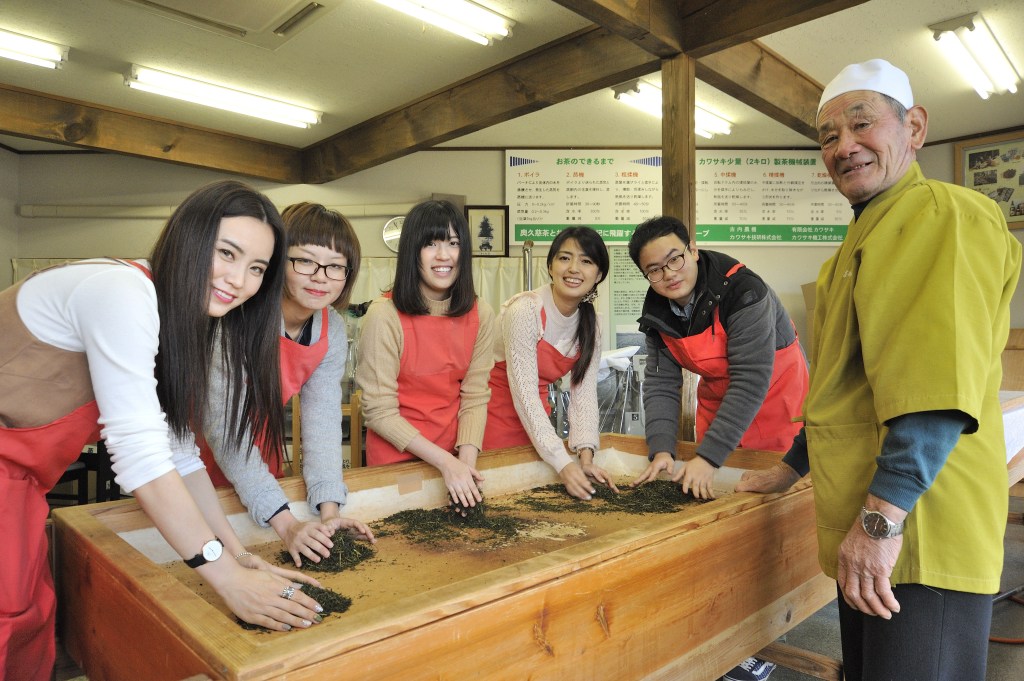
A muster of us encircled a gentleman in his 70s, his amiable face lined with wrinkles, seemingly more from exuding joy rather than fraught from hardship, given his ample grins. His hardened, practiced hands mesmerized us as he massaged the manually procured leaves in a heated table covered with washi paper. This crimeless modus operandi (temomi) of curing leaves was invented by Souen Nagatani in 1783 and ushered in a flamboyant new flavor profile. The fragrance of the toasted leaves was balmy and lingered in the nose with regal nuances. A generous parting gift (omiyage) of tea leaves invoked nostalgic appreciation and giddy selfishness for having procured a premium tea.
Fukuroda Falls – Daigomachi
The rich melody of running water is an aphrodisiac for the soul. The rhythmic sound resonates in the mind and you can easily lose yourself to its embrace. The many eager explorers in our midst stepped with purpose as we sauntered toward the Fukuroda Falls entrance roughly a klick away. The invigorating walk was mollified by the onset of night`s chill as the sun ducked quickly behind a silhouette of trees and the fading light bid us adieu. The dark cover of evening was placated by an ample display of brightly lit shops hawking a cornucopia of delicacies and crafts. One particular storefront was muddled with an endless array of antiques while another façade held all manner of wood touched by a craftsman`s love. Quaint eateries and cafes mingled themselves into this affectionate image and smiles infected our group of curious Georges.
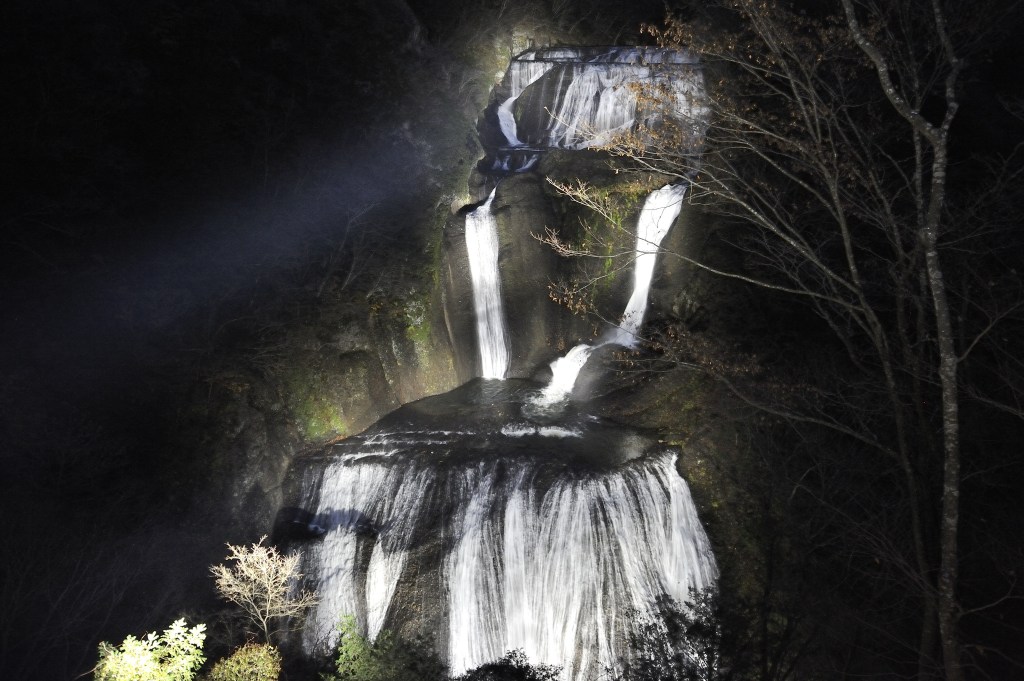
Carved into the mountain, a wide cement path steered us along a dim corridor illuminated above with modern LED fixtures that mimicked a flowing river of amber. Remnants of the facility`s past was only evident by a deeply ensconced alter where candles cast their flickering hands upon their sacred charge. The air was electrified with the orchestra of falling water and we huddled into a newly constructed elevator that eased our journey to the viewing platform. As the doors opened, we were met with loud applause in our ears as a wet, feathery touch shrouded our faces. The visual opera of nature unfolded upon each step toward the edge with only the guardrails to prevent our exhilaration from taking us further. Distinct vantage points induced a unique appreciation for the beauty of the falls segmented by four cascading plateaus.
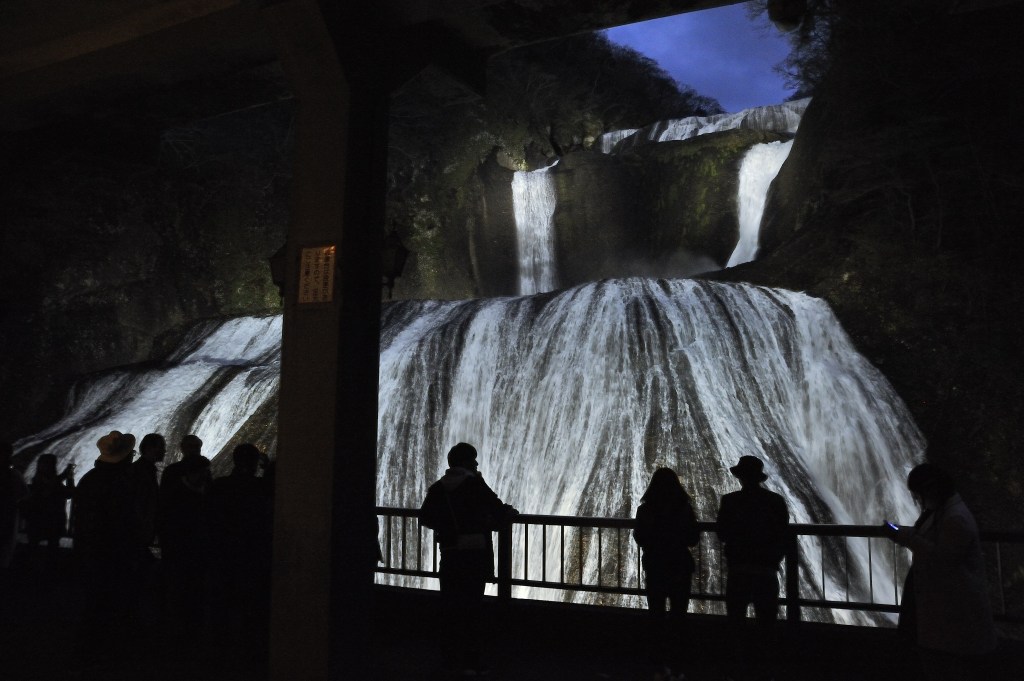
Due to nightfall, potent lights directed our thoughtful gazes to the rushing water, drowning out any peripheral imagery and inducing a surrealistic sense of oneness with the scene. We each stood enthralled, inhaling the majestic music with an unquenchable thirst as minutes drifted by unnoticed. Only the sharp bite of twilight`s prodding propelled us to advance to the next nook where it would hold us frozen along another expanse. This immaculate example of nature`s genius has many facets governed by the cycle of seasons and would soon slumber in dramatic fashion as winter`s grip held captive the river`s energy. Before long, mountaineers will dot this edifice and propel themselves up the icy blanket until that time spring was invited to return. For us, we were left to our own thoughts of appreciation for the experience and happier for it.
Ryokan – Daigomachi
Japanese style inns (ryokans) were once a burgeoning industry during the Edo period as weary travelers traversing the web of roads yearned for escape and a reprieve from the harsh terrain. Our entourage of thrill seekers was fortunate to elicit refuge at the Omoide Romankan where modern comforts blended effortlessly with traditional amenities. Cavernous tatami rooms with plush futons and filled with sparse yet tasteful furnishings awaited each of us. As custom, a yukata waited to be filled with our tired bodies, a communal uniform for guests to don as we made our way to fill our bellies with local cuisine. It is indeed a rare occasion when one can attend dinner in public wrapped only in a bathrobe varietal. You only had to tame your imagination so as not to detour your mission from glorified sustenance.
A luxurious formal dinner (kaiseki) was served consisting of an extravagant canvas of artistry and flavors harvested from local, seasonal ingredients. The meal was a bouquet of exquisite dishes ranging from an egg custard that seduced your tongue to a personalized hot pot (nabemono) that swindled your palette into grandiose admiration. A steaming vessel of rice infused with a vegetable medley, a traditional skewer of a favorite river fish (ayu), fragile tofu skin that delighted and salted pickles that flattered each bite paraded before you endlessly. Joined by a rowdy group of beer and sake, the gastronomic carnival plundered our appetites and we gave little resistance to its advances.
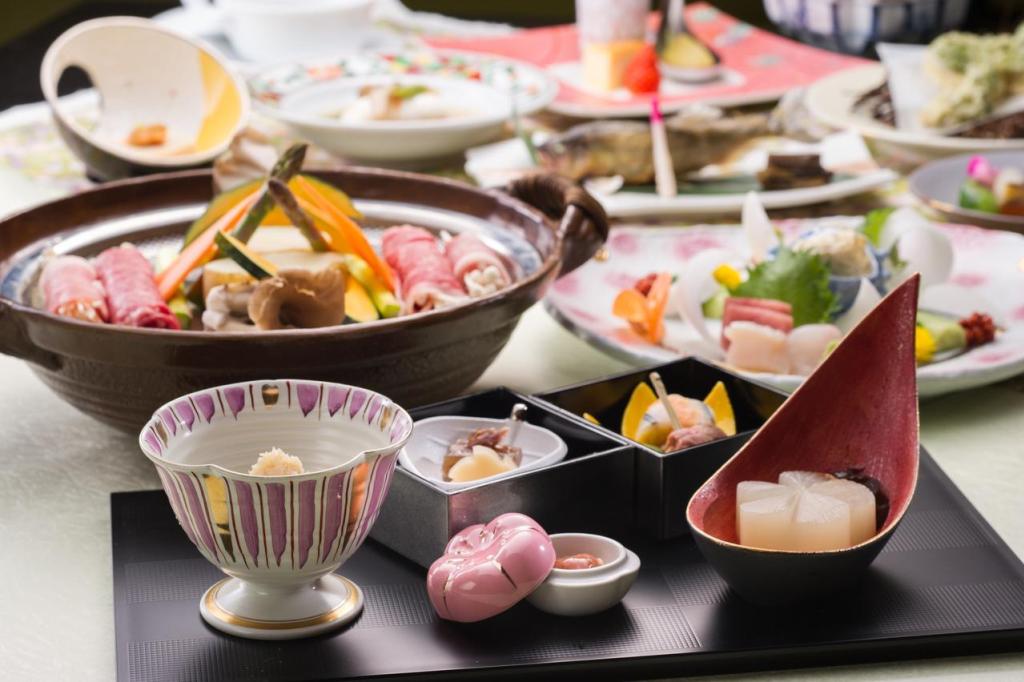
Written by: Kyu Chah








Comments
This post currently has no comments.